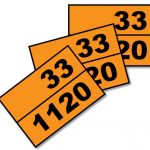Infracor GmbH has greatly simplified the time-consuming stockkeeping of orange warning signs for hazardous goods. This wholly owned subsidiary of Degussa AG now uses an customised labelling solution that saves considerable time and is resistant to light, heat and seawater.
Speed and flexibility are hallmarks of Degussa’s philosophy. There is a good reason for this: three quarters of the nearly 12 billion euros generated by the company in sales are from overseas business, so that prompt and efficient reactions are vital. The more hazardous goods that are exported overseas, the greater the challenge created by the labelling of seaworthy containers. As the integral site operator of Marl Chemical Park (Germany) and the one-stop service provider for the businesses residing there, Infracor provides the necessary packaging, dispatch and labelling materials via its subsidiary, Infracor Lager- und Speditions-GmbH (ILaS). Orange warning signs are amongst the most sought-after items. These signs are not normally permanently attached to containers, tank containers or tank wagons, as is the case with lorries or tractors with a fixed tank, but are affixed according to the individual load. The hazard identification number (referred to in Germany as the Kemler Code), which appears in the top half of the sign, is a unique code that identifies the principal danger posed by the product in question as well as other relevant hazards. Experts can therefore quickly identify the hazardous goods if necessary using this information in conjunction with the universal UN number in the bottom part.
Smart solution wanted
In the past, ILaS used self-adhesive film made of PVC to manufacture signs at an external print shop within the scope of an order. “The approval process for each warning sign variant consequently consisted of several stages,“ explains Udo Markowsky, a packaging technology specialist at Degussa. The complete procedure generally took up to three weeks from placing the order through to the finished warning sign. “Our aim was therefore to find a more effective solution together with ILaS that would provide our customers with a fast-track service,“ he adds. In the past, it was necessary to keep a comprehensive supply of all warning sign variants in stock to avoid bottlenecks, and it was impossible to forecast with any degree of accuracy which quantities would actually be required. “ILaS had warning signs for around 100 different numbers permanently available. What’s more, new products are constantly being added and older products discontinued,“ explains Wolfgang Indenbirken, Production Manager at ILaS and responsible for the procurement of packaging resources, label printing and the dispatch of samples. More than ten thousand warning signs are requested each year in total and this figure is rising by over ten percent annually. However, the need to keep an extensive range in stock was not the only problem: requests for special labels were becoming more and more frequent. “To run a conventional print order for a small quantity of a sign variant is neither efficient nor economical, particularly as nowadays flexibility and speed are increasingly the driving force“.
Printing on demand
A solution developed by the self-adhesive specialist Herma is now used instead of pre-printed PVC film. The ingenious thing about it is that each warning sign can be generated conveniently on the PC and printed out on an A3-compatible laser printer – either centrally or locally at the appropriate operating site, depending on requirements and the available resources. At the customer’s request, Herma can in future deliver suitable software directly with the product. A special labelling tool is currently being developed. The time saving is a particularly convincing aspect of this system: “The company carrying out the filling operation now receives the warning sign in two hours as opposed to three weeks,“ Indenbirken remarks. And instead of the labour-intensive management that used to be necessary for stocks of different labels, only one blank template is required. This step has been facilitated by a material known as Herma PE Laser. This film product is based on a new generation of materials with UV-treated, acrylic, pressure-sensitive adhesive. The material is extremely resistant to water, heat and ageing, with no tendency to become brittle or discolour. It is also resis-tant to seawater “… an important factor when you consider that much of our customers‘ business is focused on overseas exports,“ Indenbirken continues. Despite these outstanding properties, lettering can still be applied to the material using any popular laser printer. Herma prints only the orange background and the black frame on the label sheet. The inks have meanwhile passed the rigorous British Standard seawater resistance tests (BS 5609, Part 3). The hazard identification number and/or the UN number can be applied when the need arises. The toner fuses with the plastic layer of the label when passing through the printer and is reliably burned into the surface. The individual imprint is also water-resistant providing a suitable toner is used. This solution represents an efficient alternative not only to PVC film but also to the paper-based wet glue labels that are still in widespread use.
Reliable on critical surfaces
It was no easy task to convince the packaging experts at Degussa and Infracor. “We subjected the new material to rigorous trials in 2005,“ Udo Markowsky emphasises. “During these tests, printed labels were exposed to the sun and rain for several months. The colours didn’t fade at all, nor did the labels come unstuck“. The PE Laser solution achieved good marks in all important categories (light fastness and adhesion) similar to the PVC-based film used in the past, but with a clear advantage as regards handling, because PVC signs cannot be created on the spot using a PC and printer. The experienced labelling specialists at Degussa and Infracor were equally impressed by another attribute: the surfaces to which the labels are applied are often dirty, mainly owing to remnants of old labels on containers subject to frequent handling. The performance of the Herma labels was unaffected by these critical conditions. “They adhere reliably even to surfaces like these,“ Indenbirken concludes.
cpp 450
Self adhesive materials of Herma
Directly to Infracor Lager- und Speditions-GmbH
Welcome to Degussa
Share:








